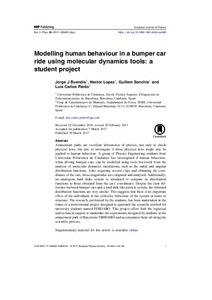Mostra el registre d'ítem simple
Modelling human behaviour in a bumper car ride using molecular dynamics tools: a student project
| dc.contributor.author | Buendía Morales, Jorge Juan |
| dc.contributor.author | López Ospina, Hector |
| dc.contributor.author | Sanchis, Guillem |
| dc.contributor.author | Pardo Soto, Luis Carlos |
| dc.contributor.other | Universitat Politècnica de Catalunya. Departament de Física |
| dc.date.accessioned | 2017-05-26T11:21:14Z |
| dc.date.available | 2017-05-26T11:21:14Z |
| dc.date.issued | 2017-05-01 |
| dc.identifier.citation | Buendía-Morales, J.J., López, H., Sanchis, G., Pardo, L. Modelling human behaviour in a bumper car ride using molecular dynamics tools: a student project. "European journal of physics", 1 Maig 2017, vol. 38, núm. 3, p. 035802-035811. |
| dc.identifier.issn | 0143-0807 |
| dc.identifier.uri | http://hdl.handle.net/2117/104917 |
| dc.description.abstract | Amusement parks are excellent laboratories of physics, not only to check physical laws, but also to investigate if those physical laws might also be applied to human behaviour. A group of Physics Engineering students from Universitat Politècnica de Catalunya has investigated if human behaviour, when driving bumper cars, can be modelled using tools borrowed from the analysis of molecular dynamics simulations, such as the radial and angular distribution functions. After acquiring several clips and obtaining the coordinates of the cars, those magnitudes are computed and analysed. Additionally, an analogous hard disks system is simulated to compare its distribution functions to those obtained from the cars' coordinates. Despite the clear difference between bumper cars and a hard disk-like particle system, the obtained distribution functions are very similar. This suggests that there is no important effect of the individuals in the collective behaviour of the system in terms of structure. The research, performed by the students, has been undertaken in the frame of a motivational project designed to approach the scientific method for university students named FISIDABO. This project offers both the logistical and technical support to undertake the experiments designed by students at the amusement park of Barcelona TIBIDABO and accompanies them all along the scientific process. |
| dc.format.extent | 10 p. |
| dc.language.iso | eng |
| dc.subject | Àrees temàtiques de la UPC::Física |
| dc.subject.lcsh | Molecular dynamics |
| dc.subject.lcsh | Bumper cars |
| dc.title | Modelling human behaviour in a bumper car ride using molecular dynamics tools: a student project |
| dc.type | Article |
| dc.subject.lemac | Dinàmica molecular |
| dc.contributor.group | Universitat Politècnica de Catalunya. GCM - Grup de Caracterització de Materials |
| dc.identifier.doi | 10.1088/1361-6404/aa64f8 |
| dc.relation.publisherversion | http://iopscience.iop.org/article/10.1088/1361-6404/aa64f8/meta;jsessionid=D3806FEDFF22CFAE46440C41DA2E7A92.c1.iopscience.cld.iop.org |
| dc.rights.access | Open Access |
| local.identifier.drac | 20329786 |
| dc.description.version | Postprint (published version) |
| local.citation.author | Buendía-Morales, J.J.; López, H.; Sanchis, G.; Pardo, L. |
| local.citation.publicationName | European journal of physics |
| local.citation.volume | 38 |
| local.citation.number | 3 |
| local.citation.startingPage | 035802 |
| local.citation.endingPage | 035811 |
Fitxers d'aquest items
Aquest ítem apareix a les col·leccions següents
-
Articles de revista [2.208]
-
Articles de revista [332]


